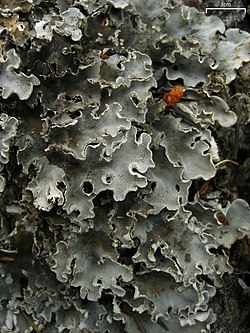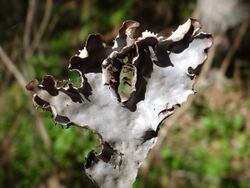Biology:Peltigera rufescens
| Peltigera rufescens | |
|---|---|

| |
| Scientific classification | |
| Domain: | Eukaryota |
| Kingdom: | Fungi |
| Division: | Ascomycota |
| Class: | Lecanoromycetes |
| Order: | Peltigerales |
| Family: | Peltigeraceae |
| Genus: | Peltigera |
| Species: | P. rufescens
|
| Binomial name | |
| Peltigera rufescens (Weiss) Humb. (1793)
| |
| Synonyms[1] | |
|
List
| |
Peltigera rufescens, commonly known as the field dog lichen, is a species of terricolous (ground-dwelling), foliose lichen in the family Peltigeraceae. The common and widespread species has a cosmopolitan distribution.
Taxonomy
The lichen was first formally described as a variety of Lichen caninus 1770 by Friedrich Wilhelm Weiss. At that time, all lichens were classified in the eponymous genus Lichen, based on Carl Linnaeus' influence. Alexander von Humboldt transferred it to the genus Peltigera and promoted it to the status of species in 1793.[2] A vernacular name for the species is field dog lichen.[3]
The complete mitochondrial genome sequence of Peltigera rufescens was published in 2021. It has 65,199 base pairs and a cytosine+guanine content of 26.7%. Molecular phylogenetic analysis suggests a close relationship with Peltigera membranacea.[4]
Description
Peltigera rufescens has a grey to brown coloured thallus that is often covered with a heavy tomentum (closely matted or fine hairs).[3] It forms rosettes up to 20 cm (8 in) in diameter.[5] The lobes comprising the thallus usually measure 5–10 millimetres (0.2–0.4 in) wide and have edges that are curled upwards. The undersurface of the thallus is strongly veined, dark in colour with a paler margin. Rhizines on the underside affix the lichen to its substrate; near the centre they are so dense so as to form an almost continuous mat. Fruit bodies, or apothecia, are common in this species. They are saddle shaped and dark red brown in colour.[3] The ascospores usually have between 3 and 5 septa and measure 40–70 by 3–5 μm. Conidiomata are sometimes produced by the lichen; the conidia are 7–10 by 2.5–4.5 μm.[5] The photobiont partner of Peltigera rufescens is cyanobacteria from the genus Nostoc.[6]
No lichen products are associated with Peltigera rufescens, and consequently, the expected results of standard lichen spot tests are all negative.[5]
If grown in a metal-polluted environment, Peltigera rufescens will have a reduction in thallus size and in rhizine length, as well as denser growth of the rhizines, veins that are more profusely branched, and an increase in volume of the medulla.[7] When treated with mercury, cadmium, or nickel, P. rufescens chlorophyll α and carotenoid concentrations will also decrease.[8][9] As with other lichens, P. rufescens is a bioaccumulator of heavy metals. This may be due to the thallus having a large surface area in contact with the substrate. P. rufescens also has free amino acid concentrations higher than other lichens in similar polluted habitats, comparable to vascular plants, suggesting that this may play a role in heavy metal tolerance.[10]
Habitat and distribution
Peltigera rufescens is a common and widespread lichen with a cosmopolitan distribution. It is most often encountered in dry, sunny habitats. It prefers more or less basic soils.[5] Individuals that grow in association with mosses tend to grow more robustly and have a higher amount of chlorophyll α then those that do not.[11] Not only does the moss provides a buffer against extremes in temperature variation, the moss-associated thalli have higher photosynthetic rates, and increased protection against desiccation. Additionally, their thalli are thicker, leading to enhanced water retention. Mosses that have been recorded associating with Peltigera rufescens include Racomitrium heterostichum, Campylopus introflexus, Hypnum cupressiforme, and Polytrichum juniperinum.[11] A study of the high-elevation biological soil crust associated with the volcanic tephra in Hawaii's Haleakalā Crater found that Peltigera rufescens was one of the two important components of this crust (the other was the moss Grimmia torquata) and occurred in about a quarter of soil specimens sampled.[12]
Ecology
Preussia peltigerae,[13] Dinemasporium strigosum, Lichenopenicillus versicolor, Nectriopsis lecanodes, Norrlinia peltigericola,[14] and Scutula didymospora are lichenicolous fungi that use Peltigera rufescens as a host. In the case of Scutula didymospora, the relationship appears to be commensalistic, as the fungus, which develops on the underside of the thallus, does not cause any damage, discolouration or galls.[15]
In one experiment, to test the effect of thallus hydration on metabolic activity, the photosystem II fluorescence ofPeltigera rufescens was monitored for a full year. The lichen was inactive for 46.5% of the time, active during daylight for 25.6%, and hydrated at night for 27.9% of the time. Its photosynthetic activity and moisture levels were correlated with environmental conditions, with four distinct activity patterns discerned. Despite previous experimental findings suggesting high light could be harmful when the lichen is hydrated, field observations found little evidence of damage, suggesting an unknown photoprotection mechanism possibly involving certain carotenoids.[16] In a study examining the effects of long-term UV-B radiation on lichen species, Peltigera rufescens, typically found in open meadow spaces, demonstrated increased hydrogen peroxide content and superoxide dismutase activity, indicating a possible adaptive response to oxidative stress caused by UV-B exposure. This lichen species displayed a higher resilience to UV-B compared to Peltigera aphthosa, suggesting a species-specific response to UV-B radiation that likely stems from their typical habitat's light conditions.[17]
Bioactivity
Laboratory experiments suggest that extracts of Peltigera rufescens have insecticidal activity against the maize weevil (Sitophilus zeamais).[18]
References
- ↑ "Synonymy: Peltigera rufescens (Weiss) Humb., Fl. Friberg. Spec. (Berlin): 2 (1793)". Species Fungorum. http://www.speciesfungorum.org/Names/SynSpecies.asp?RecordID=399354.
- ↑ von Humboldt, A. (1793) (in la). Florae Fribergensis Specimen plantas cryptogamicas praesertim subterraneas exhibens. https://www.biodiversitylibrary.org/item/267829#page/5/mode/1up.
- ↑ 3.0 3.1 3.2 Brodo, Irwin M.; Sharnoff, Sylvia Duran; Sharnoff, Stephen (2001). Lichens of North America. Yale University Press. pp. 520–521. ISBN 978-0300082494.
- ↑ Wang, Lidan; Mamut, Reyim (2021). "Mitochondrial genome from the lichenized fungus Peltigera rufescens (Weiss) Humb, 1793 (Ascomycota: Peltigeraceae)". Mitochondrial DNA Part B 6 (8): 2186–2187. doi:10.1080/23802359.2021.1944374. PMID 34263045.
- ↑ 5.0 5.1 5.2 5.3 Hitch, C.J.B; Fletcher, A.; James, P.W.; Purvis, O.W. (2009). "Peltiger". The Lichens of Great Britain and Ireland. London: British Lichen Society; Natural History Museum. pp. 309–338. ISBN 978-0-9540418-8-5.
- ↑ Jüriado, Inga; Kaasalainen, Ulla; Jylhä, Maarit; Rikkinen, Jouko (2019). "Relationships between mycobiont identity, photobiont specificity and ecological preferences in the lichen genus Peltigera (Ascomycota) in Estonia (northeastern Europe)". Fungal Ecology 39: 45–54. doi:10.1016/j.funeco.2018.11.005.
- ↑ Goyal, R.; Seaward, M.R.D. (1982). "Metal uptake in terricolous lichens. ii. effects on the morphology of Peltigera canina and Peltigera rufescens". New Phytologist 90 (1): 73–84. doi:10.1111/j.1469-8137.1982.tb03243.x.
- ↑ Pisani, Tommaso; Munzi, Silvana; Paoli, Luca; Bačkor, Martin; Kováčik, Jozef; Piovár, Juraj; Loppi, Stefano (2011). "Physiological effects of mercury in the lichens Cladonia arbuscula subsp. mitis (Sandst.) Ruoss and Peltigera rufescens (Weiss) Humb.". Chemosphere 82 (7): 1030–1037. doi:10.1016/j.chemosphere.2010.10.062. PMID 21094972. Bibcode: 2011Chmsp..82.1030P.
- ↑ Bačkor, Martin; Kováčik, Jozef; Piovár, Juraj; Pisani, Tommaso; Loppi, Stefano (2010). "Physiological aspects of cadmium and nickel toxicity in the lichens Peltigera rufescens and Cladina arbuscula subsp. mitis". Water, Air, and Soil Pollution 207 (1): 253–262. doi:10.1007/s11270-009-0133-6. Bibcode: 2010WASP..207..253B.
- ↑ Bačkor, Martin; Klejdus, Bořivoj; Vantová, Ivana; Kováčik, Jozef (2009). "Physiological adaptations in the lichens Peltigera rufescens and Cladina arbuscula var. mitis, and the moss Racomitrium lanuginosum to copper-rich substrate". Chemosphere 76 (10): 1340–1343. doi:10.1016/j.chemosphere.2009.06.029. PMID 19595434. Bibcode: 2009Chmsp..76.1340B.
- ↑ 11.0 11.1 Colesie, Claudia; Scheu, Sarah; Green, T.G. Allan; Weber, Bettina; Wirth, Rainer; Büdel, Burkhard (2011). "The advantage of growing on moss: facilitative effects on photosynthetic performance and growth in the cyanobacterial lichen Peltigera rufescens". Oecologia 169 (3): 599–607. doi:10.1007/s00442-011-2224-5. PMID 22183705.
- ↑ Pérez, Francisco L. (2020). "Growth of Grimmia mosses on volcanic tephra: Geoecological processes of biocrust development in Haleakalā crater (Maui, Hawai′i)". CATENA 195: e104911. doi:10.1016/j.catena.2020.104911. Bibcode: 2020Caten.19504911P.
- ↑ Diederich, Paul; Lawrey, James D.; Ertz, Damien (2018). "The 2018 classification and checklist of lichenicolous fungi, with 2000 non-lichenized, obligately lichenicolous taxa". The Bryologist 121 (3): 340–425 (see p. 371). doi:10.1639/0007-2745-121.3.340.
- ↑ Etayo, J. (2017) (in es). Hongos liquenícolas de Ecuador. Opera Lilloana. 50. San Miguel de Tucumán, Argentina: Fundación Miguel Lillo. pp. 152, 180, 253, 296, 321. http://www.lillo.org.ar/revis/opera-lilloana/2017-opl-v50.pdf.
- ↑ Hawksworth, David L.; Miądlikowska, Jolanta (1997). "New species of lichenicolous fungi occurring on Peltigera in Ecuador and Europe". Mycological Research 101 (9): 1127–1134. doi:10.1017/s0953756297003778.
- ↑ Lange, Otto L.; Leisner, Johanna M.R.; Bilger, Wolfgang (1999). "Chlorophyll fluorescence characteristics of the cyanobacterial lichen Peltigera rufescens under field conditions". Flora 194 (4): 413–430. doi:10.1016/s0367-2530(17)30932-5.
- ↑ Shelyakin, Mikhail A.; Silina, Ekaterina V.; Golovko, Tamara K. (2001). "The effect of UV-B radiation on the antioxidant system in the Peltigera aphthosa and Peltigera rufescens lichens". Journal of Siberian Federal University. Biology (Siberian Federal University) 14 (3): 328–338. doi:10.17516/1997-1389-0359.
- ↑ Yildirim, E.; Emsen, B.; Aslan, A.; Bulak, Y.; Ercisli, S. (2012). "Insecticidal activity of lichens against the maize weevil, Sitophilus zeamais Motschulsky (Coleoptera: Curculionidae)". Egyptian Journal of Biological Pest Control 22: 151–156. https://www.researchgate.net/publication/291351895.
Wikidata ☰ Q10549593 entry
 |


